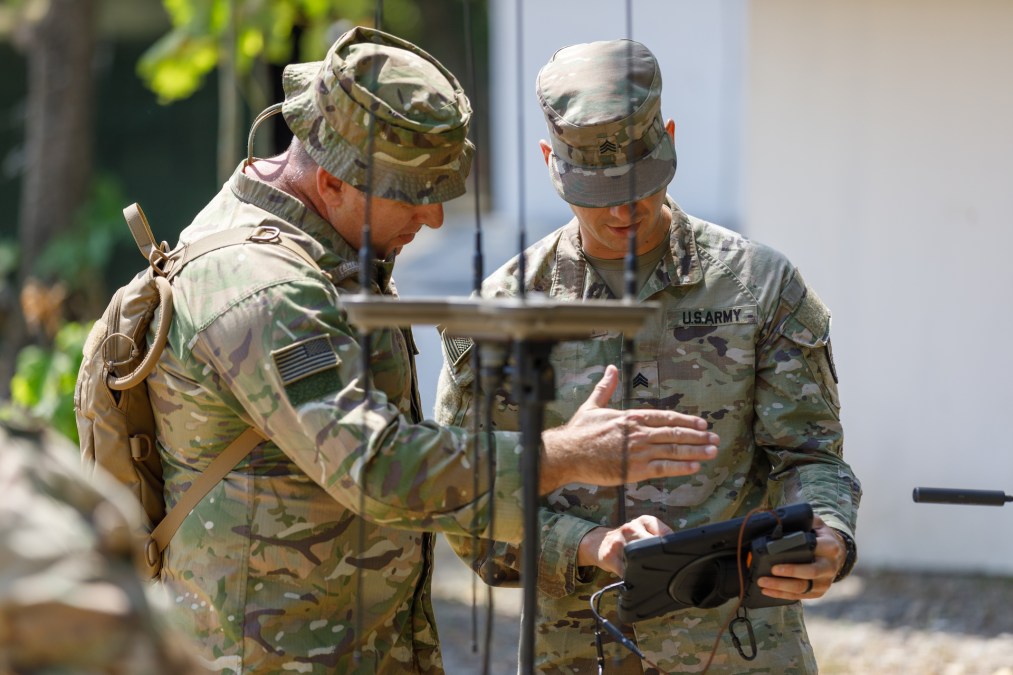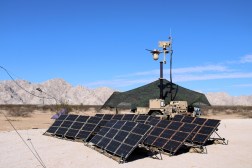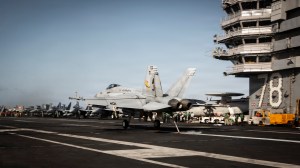Army shaping electronic warfare approach for the Pacific

PHILADELPHIA — After years of focusing on and designing capabilities for the European theater against threats in that region, the Army is turning its attention to devising electronic warfare systems for the Pacific.
With predicable troop rotations and forces stationed in Europe, undoubtably a primarily land-based military theater, the Army had developed much of its EW capability to counter the Russian threat. However, now that the Department of Defense views China as its top competitor, the Army must develop systems for the unique Pacific region, typically thought of as a maritime theater with thousands of small islands and jungle terrain.
“When we’re talking about island hopping, you’re talking about small amounts of land, lots of ocean. Physics gets a vote when it comes to what happens to energy and signals of water versus land,” Brig. Gen. Wayne “Ed” Barker, program executive officer for intelligence, electronic warfare and sensors, said at the Army’s Technical Exchange Meeting May 30 in Philadelphia. “What it’s going to require is it’s layered capabilities. Our forces are going to be geographically dispersed, but the reality is they’re going to need to work independently, but they also needs to be integrated. That’s really what it boils down to. There’s not going to be a silver-bullet gang.”
The Army had divested much of its electronic warfare capability at the conclusion of the Cold War. As it works to build up its arsenal, it’s now looking at tailoring toward different regions. The unique threats in each theater as well as the terrain — which affects how signals travel — means that a system in one area won’t be ideal in another.
Barker also stressed that the Pacific fight will be joint and coalition operations.
The Army a few weeks ago held a first-of-its-kind holistic EW tabletop exercise at Aberdeen Proving Ground, Maryland, with roughly 90 participants from a variety of units to best understand the capability needs and gaps as they apply to electronic warfare in the Pacific.
Operational participants— which included I Corps, III Corps, XVIII Airborne Corps, Multi-Domain Task Force and several divisions, among others — laid out how they would fight from an electronic warfare standpoint. The result was they all diagramed different approaches, highlighting how units are innovating on the fly and approaching operational challenges from various perspectives.
The unique nature of the Pacific environment and the threat facing U.S. forces necessitates basic characteristics of capabilities for EW systems, according to officials, including multifunctional and platform-agnostic systems so as to not tie capabilities and units to specific platforms; disaggregating sensors from effectors so soldiers and their platforms are more survivable; and reprogrammable systems so that when new signals are discovered, fixes can be rapidly injected.
“It’s going to take a lot of different systems and capabilities and layering those to go get over the physics problem of the” area of responsibility, Col. Michael Arner, who services on a Pacific-focused Multi-Domain Task Force, said at the conference.
To help with the physics and distance problems that the Pacific theater presents, officials described the need for launched effects, with some calling them “critical” for that region.
“EW payloads will also be resident on launched effects. That’s how we overcome the tyranny of distance in the physics. That’s what we have right now, we have the launched effects and we have the high-altitude platforms [and] the ability to drift and provide downward-facing effects,” Col. Gary Brock, capability manager for electronic warfare, who is responsible for developing requirements for new EW systems, said.
Joint fight
Aside from materiel solutions, officials described the necessity of joint and coalition integration to address the physics and distance concerns.
“As we look at the role of Army EW in the Pacific here, I think it’s important to know that the variety of threats, the diversity, the terrain that we face and the distances all require jointness above everything else. It’s all about the joint fight and where are we contributing there,” Arner said. “Interoperability, both across the joint force — this is going to be a partner and coalition environment — we have to be interoperable across the spectrum of our partners.”
That interoperability will help improve the speed of decision-making and effects that will be essential to defeating sophisticated threats from the Chinese military.
Officials noted that when fighting alongside partners, much of it will be below the Five Eyes level (Five eyes is an intelligence-sharing relationship between the United States, United Kingdom, Australia, New Zealand and Canada), meaning there will be more arduous barriers to sharing data. Machine-to-machine speed and integrating at the data level without cross-domain solutions will be critical.
From a land forces standpoint, the Army and Marine Corps have begun more closely cooperating on developing common standards and capabilities.
The Army recently decided to shift the approach for the next phase of its Electronic Warfare Planning and Management Tool used for visualizing potential effects in the spectrum and chart courses of action to prevent their forces and systems from being jammed during operations, opting to shift the program’s capabilities to the Tactical Assault Kit (TAK) framework, where applications for situational awareness data and geospatial visualizations can be created.
“The EWPMT Next is fundamentally integrated from the get-go by developers across the Marine Corps and the Army,” Brock said.
Barker described how the Army is looking for every opportunity to make sure there’s a level of interoperability and commonality from a user interface, which will provide the ability to pivot and update as needed.
There is greater recognition across the U.S. government regarding the need for the services to partner closely.
“It’s incredibly important that we’re going down this path because as I talked to staffers and congressional members and even at the OSD level, the question is always, ‘What are the other services doing?’” Barker explained. “If we’re not having these types of conversations then we’re actually not doing our due diligence when it comes to making sure we’re making the best use of taxpayer dollars.”
Currently, however, those relationships are in some cases ad hoc and are reliant on the initiative of stakeholders to hold conversations with their counterparts.
“A lot of new kit is coming online, but right now we’re not integrated into that overall C2 system and into, in this case, the Joint Fires Network,” Arner said, describing a prototyping effort that addresses the immediate needs of combatant commands. “How are we feeding that so that we have a true sensor-to-shooter [connection] at the machine-to-machine speed?”
A top Pentagon priority is an initiative called Combined Joint All-Domain Command and Control (CJAD2), which envisions how systems across the entire battlespace from all the U.S. military services and key international partners could be more effectively and holistically networked to provide the right data to commanders, faster. The eventual goal is that a sensor from any service can pass data to another platform from another service or partner, and the best available capability can deliver the effects on the battlefield.
The Joint Fires Network is also serving as a pathfinder for CJADC2.
Brock told DefenseScoop that the Army is working through Strategic Command’s Joint Electromagnetic Spectrum Operations Center, the heart of DOD’s electromagnetic spectrum operations, to increase coordination when it comes to the reprogramming enterprise.
He noted that it still comes down to service-to-service discussions. He is in contact with the Air Force’s 350th Spectrum Warfare Wing as well as Naval officials at Point Magu, California, that work on EA-18G Growler reprogramming as well as Marine Corps air reprogramming.
“Right now, it’s an effort across the services because I can’t point and say, ‘That’s the owner of this at the Pentagon,’” he said.






